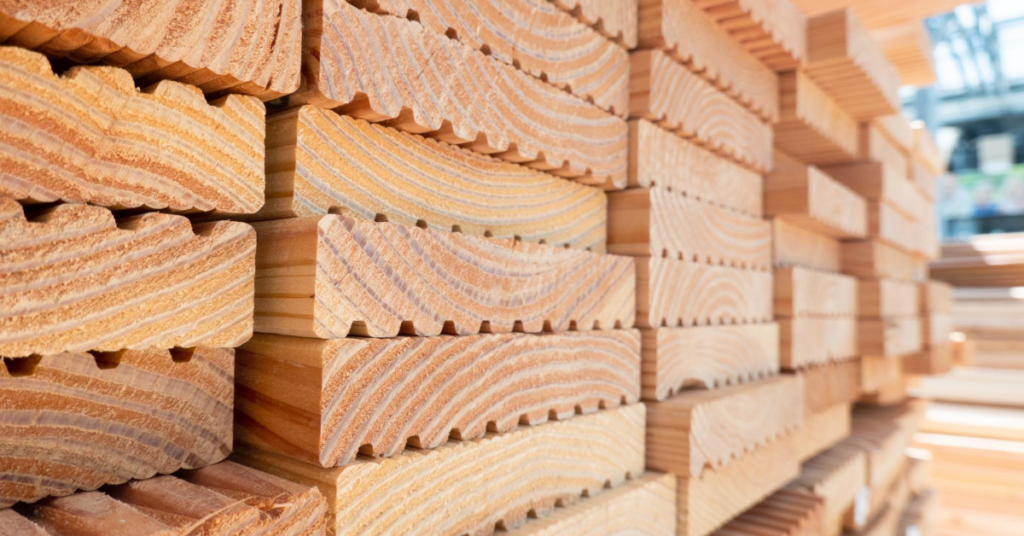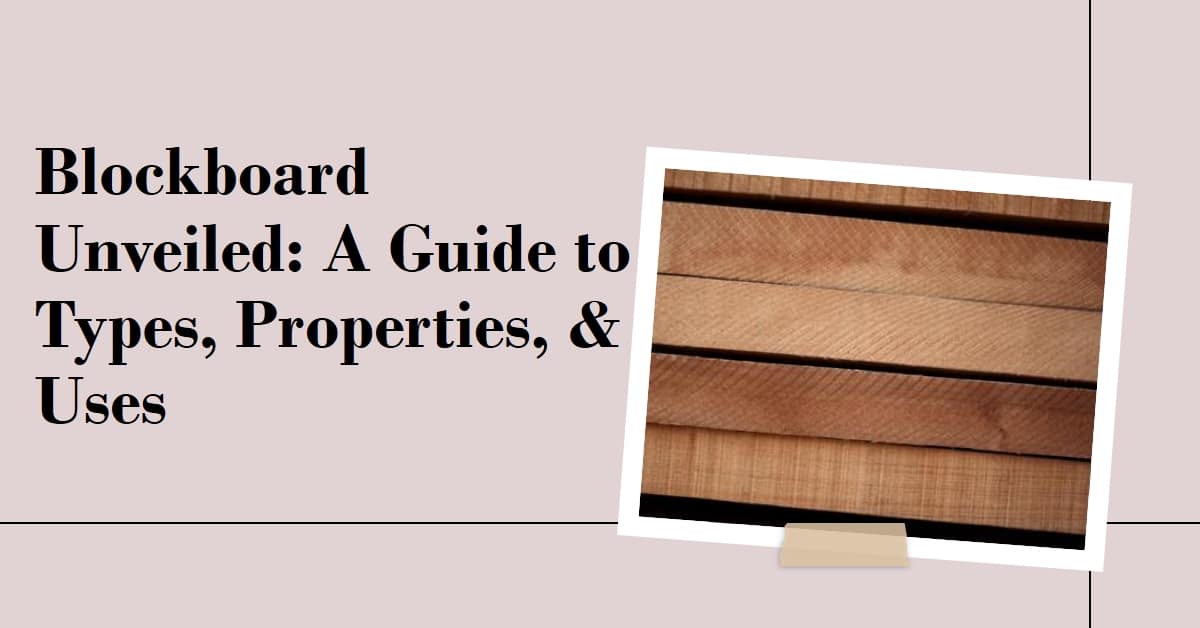Blockboard has gained popularity for its strength, stability, and affordability, it stands out as a reliable choice for a variety of applications. In this guide, we’ll delve into the intricacies of blockboard, exploring its types, properties, and diverse uses. Whether you’re a woodworking enthusiast, a DIY, or a construction professional, understanding its nuances can significantly enhance your projects.
What is a Blockboard?

Blockboard is a type of engineered wood panel characterized by its robust properties and versatile applications. It consists of a core made from solid wood blocks or strips arranged side by side and sandwiched between layers of veneer or plywood. This construction imparts several advantageous properties to blockboard, including strength, stability, and resistance to warping. The core’s solid wood composition provides excellent screw-holding capacity, making it suitable for various joinery applications in furniture making and interior construction.
Additionally, blockboard exhibits relatively smooth surfaces, making it ideal for finishing with paints, laminates, or veneers to achieve desired aesthetics. While not inherently waterproof, blockboard can withstand moderate moisture levels with proper sealing and finishing. Common examples of blockboard usage include manufacturing furniture, cabinetry, doors, shelves, and partitions. Overall, blockboard serves as a versatile building material valued for its strength, stability, and adaptability in diverse woodworking projects.
Types of Blockboard
1. Hardwood Block Board:
This type of blockboard is crafted using hardwood blocks for the core. Hardwoods like teak, oak, or maple are common choices, imparting exceptional strength and durability to the final product. It is ideal for applications where sturdiness is paramount, such as furniture construction and structural elements.
2. Softwood Block Board:
These types of blockboards are made by joining softwood strips under high pressure, resulting in a sturdy and durable product. The high-pressure process ensures that the core is strong and can withstand various stresses. This makes high-pressure blockboards ideal for use in furniture, cabinets, and other applications where strength and stability are crucial.
3. Moisture-Resistant Block Board:
For areas prone to high humidity or moisture, a moisture-resistant board is the go-to choice. These water-resistant blockboards are made using Boiling Waterproof resin to fix strips inside the core, making them ideal for areas where moisture exposure is a concern. They are durable, easy to handle, and can hold screws and nails easily. With their water-resistant properties, these blockboards are suitable for both interior and exterior use, providing a reliable solution for different construction needs
4. Fire-Retardant Block Board:
This type of board is treated with fire-retardant chemicals, making it suitable for applications where fire safety is a priority. Commonly used in the construction of doors, partitions, and other structures requiring compliance with fire safety regulations.
5. Decorative Block Board:
Crafted with an emphasis on aesthetics, the decorative board features a visually appealing surface veneer. This can include exotic hardwood veneers or artistic designs to enhance the overall appearance. It is popular in the production of high-end furniture pieces and decorative elements in interior design.
Properties of Blockboard
Strength and Stability
The unique construction of the blockboard, with its solid wood core, imparts exceptional strength and stability. It is less prone to warping or twisting compared to other wood-based materials.
Smooth Surface
It typically features a smooth and even surface, thanks to the top and bottom veneer layers. This makes it an excellent choice for applications where a polished finish is desired.
Workability
It is relatively easy to work with using common woodworking tools. It can be sawn, drilled, and shaped with ease, allowing for intricate designs and precise constructions.
Versatility
The variety of blockboard types available makes it a versatile material for a wide range of applications. From structural components to decorative elements, block boards can be tailored to meet diverse needs.
Durability
Depending on the type of wood used for the core and the quality of manufacturing, blockboard exhibits a high level of durability. Properly maintained, it can withstand the test of time, making it a long-lasting choice for various projects.
Advantages of Blockboard
- Lightweight and Easy Transport: Blockboards are lighter than plywood, facilitating easier transportation to the desired location, and thus reducing transportation costs.
- Suitability for Interior Doors: Due to their lightweight, blockboards are commonly used for interior doors, enhancing convenience during installation.
- Cost-Effectiveness: Blockboards are cheaper than plywood, making them a cost-effective choice for interior projects, helping to reduce overall expenses without compromising quality.
- Stiffness for Long Furniture Pieces: Blockboards’ resistance to bending makes them ideal for constructing long furniture pieces such as panels, bookshelves, benches, and tables, ensuring structural integrity over extended spans.
- Custom Thickness for Design: Blockboards are recommended for furniture projects requiring specific thicknesses according to custom design requirements, offering versatility in design options.
- Dimensional Stability: Blockboards exhibit good dimensional stability even in humid environments, resisting warping and cracking over time, ensuring durability and longevity.
- Excellent Fastening Properties: Blockboards hold screws and nails securely, providing stability and ease of assembly, surpassing particle boards and MDF in fastening capability.
- Ease of Carpentry: Blockboards are easy to work with using standard woodworking tools, enabling carpenters to efficiently execute their projects without encountering difficulties.
- Moisture Resistance: Certain varieties of blockboards, such as BWP (Boiling Water Proof), offer enhanced resistance to water and humidity, ensuring longevity and suitability for moist environments.
- Environmental Friendliness: Blockboards made from sustainable sources contribute to environmental conservation efforts while offering performance benefits, aligning with eco-conscious building practices.
Disadvantages of Blockboard
- Limited Dependability: Blockboards, being lighter in weight, may lack the robustness and reliability of denser materials, leading to concerns about their overall dependability for heavy-duty applications.
- Challenges for Carpenters: The presence of unwanted gaps between softwood strips within blockboards can pose challenges for carpenters during fabrication, potentially affecting the quality and precision of the final product.
- Risk of Cracking: Careful attention is required during screwing and nailing processes, as blockboards may be prone to cracking if fasteners are not applied with precision or if excessive force is exerted.
- Potential for Shrinkage and Swelling: Blockboards are susceptible to changes in moisture levels, leading to shrinkage or swelling of the board over time, which can affect structural integrity and aesthetics.
- Variable Durability: The durability of blockboards is not guaranteed and may vary depending on factors such as wood quality, adhesive used, and environmental conditions, leading to uncertainty regarding long-term performance.
- Susceptibility to Insect Damage: If the softwood strips used in blockboards are of low quality or susceptible to insect infestation, there is a risk of deterioration over time, compromising the structural integrity of the board.
- Difficulty in Working with Gaps: In cases where small gaps exist within the core of blockboards, working with them can be challenging, as screws or nails may inadvertently penetrate these gaps instead of the core, potentially compromising the strength and stability of assembled furniture pieces.
Uses of Blockboard
- Furniture Construction: It is widely employed in the construction of furniture, ranging from sturdy cabinets and shelves to elegant tables and chairs. Its strength and smooth surface make it an ideal material for crafting durable and aesthetically pleasing furniture pieces.
- Doors and Partitions: The inherent stability and resistance to warping make it a popular choice for doors and partitions. Fire-retardant blockboard is often used in commercial buildings and residential structures to enhance safety.
- Cabinetry: In kitchens and bathrooms where moisture resistance is crucial, blockboard finds its place in the construction of cabinets and cupboards. The material’s durability ensures the longevity of these essential storage components.
- Paneling and Wall Coverings: Its panels can be used for wall paneling, providing an attractive and durable surface. In interior design, decorative blockboard adds a touch of elegance to walls, creating a visually appealing environment.
- Structural Applications: Thanks to its strength and stability, blockboard is employed in various structural applications. It is used in the construction of beams, columns, and other load-bearing elements where reliability is paramount.
- Craftsmanship and Artistry: Craftsmen and artists appreciate it for its workability and versatility. It serves as a canvas for intricate carvings, artistic engravings, and other forms of creative expression.
In conclusion, blockboard stands out as a versatile and reliable material in the realm of engineered wood products. Its diverse types cater to different needs, while its unique properties make it an excellent choice for various applications.
Whether in furniture manufacturing, construction, or interior design, blockboard’s strength, stability, and affordability make it a valuable asset for both professionals and DIY enthusiasts. As sustainable practices continue to gain importance, blockboard’s use of fast-growing wood aligns with the growing demand for eco-friendly materials in the woodworking industry. Understanding the intricacies of block board at Timber Explore empowers individuals to make informed choices when selecting materials for their projects, ensuring both functionality and longevity.

